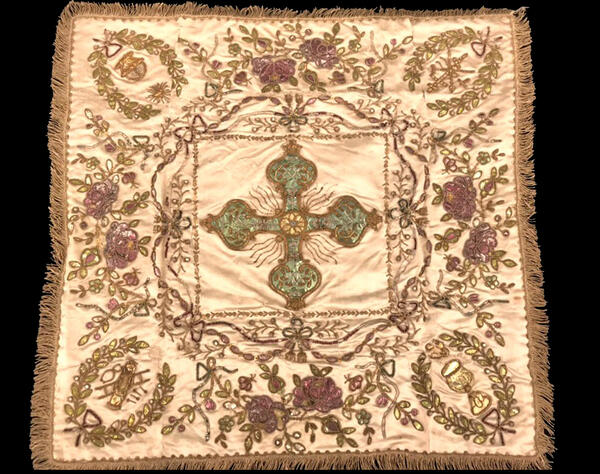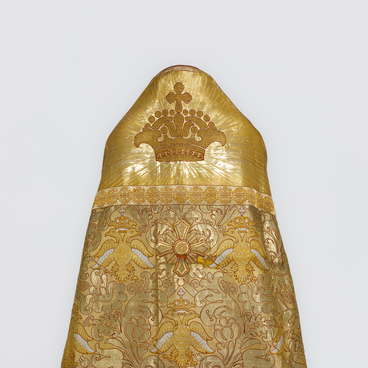An Aër in liturgy is an embroidered veil which is used to cover the Sacraments on the diskos, as well as the Gospel when it is brought out. The word Aër is first mentioned in Byzantine writings as the veil of the Heavenly Temple and the stone that sealed the tomb of Christ. The Aër is compared to the shroud of Christ, a linen cloth, which wrapped the body of the Savior after his crucifixion and death. Hence the interpretation of bringing out the Aër as a funeral procession.
The Aër was first used in the 5th century in Jerusalem. The Typikon, the liturgical statute of the Orthodox Church of the Venerable Father Sava the Sanctified, mentions that the priest is to remove the small veils from the Sacraments and to cover them with the Aër. The Aër can be large and small with the largest ones reaching up to two meters in length. The Aër was given its name because during the recitation of the “Creed”, the clergy make waving motions with the veil over the Sacraments, producing a whiff of air. The Aër blesses, covers and protects all the Holy Vessels, as mentioned in the prayer “Cover Us — Purge out of Us”. A similar ceremony is followed at the ordination of a priest, when his head and hand are covered with the Aër.
Each image in the Aër has a symbolic meaning. The olive branch in Christianity is a symbol of purification: olive oil, spices and a special balm are used to prepare myrrh, which is used during baptisms, communion, and ordination. The Holy Chalice is a sacramental vessel with the blood of Jesus Christ, which was collected by St. Joseph of Arimathea after the removal of the Savior’s body from the cross.
The Aër depicts the Nails of the Cross of the Lord, which Roman soldiers hammered into the hands and feet of Jesus on the cross. Like all of the Instruments of Christ’s Passion, the Nails are considered one of the main sacred things in Christianity. The Life-giving Cross in the center of the Aër is the cross on which, according to Christian doctrine, Jesus Christ was crucified.
A cochlear is a small spoon with a cross at the end of the handle, which is used in the Byzantine rite to serve wine from the chalice during Holy Communion. The chalice, diskos, asterisk, and cochlear are made of gold, silver, tin, or metal alloys that do not oxidize. The Crucifixion and the Entombment are among the main subjects of the Aёr.
The Aër was first used in the 5th century in Jerusalem. The Typikon, the liturgical statute of the Orthodox Church of the Venerable Father Sava the Sanctified, mentions that the priest is to remove the small veils from the Sacraments and to cover them with the Aër. The Aër can be large and small with the largest ones reaching up to two meters in length. The Aër was given its name because during the recitation of the “Creed”, the clergy make waving motions with the veil over the Sacraments, producing a whiff of air. The Aër blesses, covers and protects all the Holy Vessels, as mentioned in the prayer “Cover Us — Purge out of Us”. A similar ceremony is followed at the ordination of a priest, when his head and hand are covered with the Aër.
Each image in the Aër has a symbolic meaning. The olive branch in Christianity is a symbol of purification: olive oil, spices and a special balm are used to prepare myrrh, which is used during baptisms, communion, and ordination. The Holy Chalice is a sacramental vessel with the blood of Jesus Christ, which was collected by St. Joseph of Arimathea after the removal of the Savior’s body from the cross.
The Aër depicts the Nails of the Cross of the Lord, which Roman soldiers hammered into the hands and feet of Jesus on the cross. Like all of the Instruments of Christ’s Passion, the Nails are considered one of the main sacred things in Christianity. The Life-giving Cross in the center of the Aër is the cross on which, according to Christian doctrine, Jesus Christ was crucified.
A cochlear is a small spoon with a cross at the end of the handle, which is used in the Byzantine rite to serve wine from the chalice during Holy Communion. The chalice, diskos, asterisk, and cochlear are made of gold, silver, tin, or metal alloys that do not oxidize. The Crucifixion and the Entombment are among the main subjects of the Aёr.


